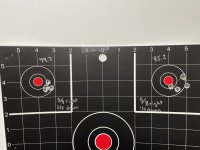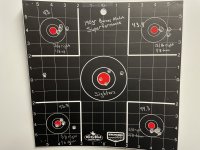What increments what you adjust the seating depth at? .005?
Also, how do you adjust your primer seating depth and reliably do it?
Depends on bullet, and how forgiving or finicky it is. Usually my first seating depth pass is 25-30 thousandths, then 10 thousandths. Fine tune pass is usually 2 thousandths.
Regarding primers, I use our Competition Primer Seater. (CPS) One click = 1 thousandth of an inch.
Reloading equipment developed by Primal Rights to elegantly solve some of the most loathsome aspects of ammunition creation.
primalrights.com
I'll give you a quick pass on how to perform the testing. Primer seating depth is the last conversation in the ignition timing and consistency discussion. First you get an average reading of your primer pocket depth in the specific lot number of brass you're dealing with. We have a new tool launching very soon which will allow you to do this with extreme ease and ultimate precision. Make sure your pocket depths are uniform. You should see less than 1.5 thousandths variance between measured cases. If you'd like to uniform them, go ahead and do that. Done properly, that will bring your pockets to within 2-4 ten thousandths, (or better.)
Then you measure the overall thickness of your specific lot number of primers. They can vary a lot, or a little. Then measure in between the anvil prongs to get your primer cup height. This will give you the anvil protrusion and let you know how much space you have to work with. CCI anvils stick pretty proud with 10-20 thousandths height... where as federal is pretty thin... sometimes only sticking up 2-5 thousandths.
In order to have consistent ignition, you will need to ensure the anvil prongs are seated firmly against the bottom of the pocket. So if your primer pocket is .125 deep, and your primer is .125 tall... you might think seating dead flush at .000 would be the call. However, anvils tend to not be perfectly flat... so I like to start at about 2 thousandths of crush. So you'd seat the primers -0.002 to start. Then you consider how much anvil protrusion you have. So if you had an anvil that set up 12 thousandths tall, and you just ate up 2 thousandths of it... you can put another 12 thousandths of crush on it. The reason that number isn't 10 thousandths, is because you can put a couple thousandths of crush on the cup itself often times without any negative effect. Obviously some primers will not respond well to full anvil crush, because it might crack the pellet. So, on to the testing portion.
You load up 3 rounds at -0.002 below flush, as this is your baseline for consistent ignition. Now we will tune for ignition timing by increasing the depth by 1 thousandth increments. One click on the CPS, and load 3 more rounds at -0.003. Do this for each click until you can linearly measure the numbers we discovered above. The important bit is to understand that just because you put 1 click on the CPS, doesn't mean the primer will move linearly in a measurable way. The primer cups are soft, and things start moving around as pressure is applied. So run the CPS uniformly and deliberately, and that 1 click will demonstrate a result... but you might not be able to measure it. Often times you will, but the relationship between the primer cup and the primer pocket is very lot number specific. Just because you don't see a linear movement, doesn't mean something different didn't happen. It did... and you might be able to shoot the difference. So you keep going like that, 1 click at a time, until you get to full anvil crush + 2 thousandths of cup crush. (or until you see primer deformation or some other thing that would indicate you should stop)
When you shoot through that batch of testing, you'll likely discover a node. Then you can bring the CPS back to the desired setting by counting clicks, and run your batch of cases. There is some more nuanced stuff to consider obviously, but that's the basic bread and butter of primer seating depth testing. If there's anything wrong with your rifles ignition timing, or the bed job on the rifle, this testing will likely reveal nothing. Conversely, if the rest of your ecosystem is tidy and well thought out... this can provide some big gains.




